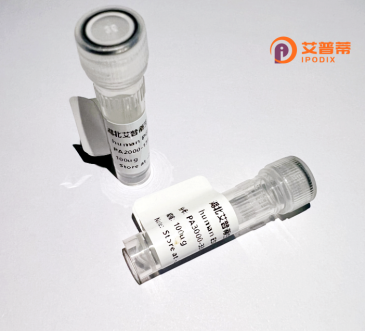
| 纯度 | >90%SDS-PAGE. |
| 种属 | Human |
| 靶点 | NKX2-5 |
| Uniprot No | P52952 |
| 内毒素 | < 0.01EU/μg |
| 表达宿主 | E.coli |
| 表达区间 | 1-324 aa |
| 活性数据 | MFPSPALTPT PFSVKDILNL EQQQRSLAAA GELSARLEAT LAPSSCMLAA FKPEAYAGPE AAAPGLPELR AELGRAPSPA KCASAFPAAP AFYPRAYSDP DPAKDPRAEK KELCALQKAV ELEKTEADNA ERPRARRRRK PRVLFSQAQV YELERRFKQQ RYLSAPERDQ LASVLKLTST QVKIWFQNRR YKCKRQRQDQ TLELVGLPPP PPPPARRIAV PVLVRDGKPC LGDSAPYAPA YGVGLNPYGY NAYPAYPGYG GAACSPGYSC TAAYPAGPSP AQPATAAANN NFVNFGVGDL NAVQSPGIPQ SNSGVSTLHG IRAW |
| 分子量 | 34.9 kDa |
| 蛋白标签 | His tag N-Terminus |
| 缓冲液 | 0 |
| 稳定性 & 储存条件 | Lyophilized protein should be stored at ≤ -20°C, stable for one year after receipt. Reconstituted protein solution can be stored at 2-8°C for 2-7 days. Aliquots of reconstituted samples are stable at ≤ -20°C for 3 months. |
| 复溶 | Always centrifuge tubes before opening.Do not mix by vortex or pipetting. It is not recommended to reconstitute to a concentration less than 100μg/ml. Dissolve the lyophilized protein in distilled water. Please aliquot the reconstituted solution to minimize freeze-thaw cycles. |
以下是3篇关于重组人NKX2-5蛋白的代表性文献摘要:
1. **文献名称**: *Structural and functional analysis of the human NKX2-5 homeodomain in congenital heart disease*
**作者**: Elliott DA et al.
**摘要**: 该研究解析了重组人NKX2-5蛋白的晶体结构,揭示其DNA结合域中特定氨基酸的突变(如Q170R)如何导致先天性心脏病,并通过体外实验证明突变体降低DNA结合能力,破坏心脏发育相关基因调控。
2. **文献名称**: *NKX2-5 regulates human cardiomyogenesis via a conserved Wnt/β-catenin pathway*
**作者**: Prall OWJ et al.
**摘要**: 利用重组NKX2-5蛋白及干细胞模型,研究发现NKX2-5通过Wnt/β-catenin信号通路促进心脏祖细胞分化,并证实其在体外心肌细胞再生中的关键作用,为心脏修复提供分子靶点。
3. **文献名称**: *Recombinant NKX2-5 protein reprograms fibroblasts into cardiac-like cells*
**作者**: Ieda M et al.
**摘要**: 通过重组NKX2-5蛋白与特定转录因子联用,成功将成纤维细胞重编程为功能性心肌样细胞,证明其在细胞治疗中的潜在应用价值,为心脏疾病再生医学提供新策略。
这些文献分别从结构功能、分子机制及转化医学角度阐明NKX2-5的核心作用。如需特定研究方向的扩展,可进一步补充。
NKX2-5. a homeodomain-containing transcription factor, plays a pivotal role in vertebrate heart development. It belongs to the NKX family of proteins and is crucial for cardiac progenitor cell specification, heart tube formation, and chamber maturation during embryogenesis. In humans, NKX2-5 mutations are linked to congenital heart defects, such as atrial septal defects, and conduction abnormalities, underscoring its functional importance. The protein regulates downstream target genes by binding to DNA motifs in promoters or enhancers, often interacting with partners like GATA4 and TBX5 to orchestrate cardiac gene networks.
Recombinant human NKX2-5 protein is engineered using expression systems (e.g., *E. coli* or mammalian cells) for biochemical and functional studies. Purified variants, often fused with tags like His or GST, enable research into its DNA-binding properties, structural interactions, and signaling pathways. Studies utilize recombinant NKX2-5 to model developmental defects, screen therapeutic compounds, and investigate epigenetic regulation in cardiac diseases. Its role in maintaining postnatal cardiomyocyte function and regenerative potential also makes it a target for heart failure therapies.
As a molecular tool, recombinant NKX2-5 accelerates mechanistic insights into cardiac development and disease, offering translational applications in diagnostics, drug discovery, and stem cell-based regenerative approaches.
×